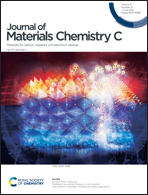Detection of electrolyte leakage from lithium-ion batteries using a miniaturized sensor based on functionalized double-walled carbon nanotubes†
Abstract
Lithium-ion batteries are widely used in our daily lives but the failure of batteries may lead to serious consequences. As a result, there is an urgent need to ensure the safety of lithium-ion batteries. Lithium-ion battery failure is often associated with electrolyte vapour leakage, which can be a warning signal. However, it is difficult to detect trace amounts of electrolyte leakage because the major components of electrolytes are redox-neutral carbonates such as dimethyl carbonate (DMC). In this study, we reported a miniaturized sensor based on functionalized double-walled carbon nanotubes to detect DMC vapours and monitor electrolyte leakage from lithium-ion batteries. The response of the sensor was obvious even when the leakage levels were as low as only 0.1 μL DMC. Real-time detection of DMC vapours and electrolytes demonstrated high sensitivity and fast response/recovery speed. Therefore, this work not only demonstrated the application of double-walled carbon nanotubes in chemical sensors to detect battery electrolytes with high sensitivity, stability, and rapid response, but also provided a promising method to improve the safety of lithium-ion batteries.



 Please wait while we load your content...
Please wait while we load your content...